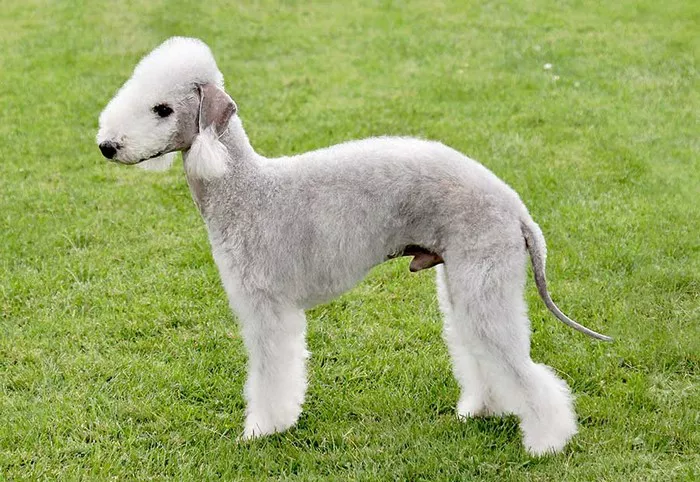3
The Bedlington Terrier, with its lamb-like curls and elegant silhouette, is a breed steeped in history. While its appearance may suggest a gentle companion, its roots lie in the rugged terrain of 19th-century England, where it evolved from a tenacious working dog to a beloved family pet. This article traces the origins of the Bedlington Terrier, exploring its genetic heritage, historical development, and transformation over centuries.
Early Ancestry: Roots in Northern England
The Bedlington Terrier’s story begins in the late 18th century in the mining regions of Northumberland, England. The breed’s ancestors were likely a mix of local terriers, including the Rothbury Terrier, a hardy breed used for hunting vermin and small game. These early dogs were valued for their agility, courage, and keen sense of smell.Breeders in the area aimed to create a versatile working dog capable of thriving in harsh environments. To enhance speed and stamina, they crossed local terriers with Whippets, a sighthound known for its lightning-fast sprints. The addition of Dandie Dinmont Terriers contributed to the Bedlington’s distinctive low-to-the-ground build and tenacity. Some theories also suggest Otterhounds were included for their water-retrieving skills, though this remains debated due to limited historical records.By the early 1800s, these crossbreeding efforts produced a dog with a unique combination of traits: a narrow head, arched back, and a dense, curly coat that protected it from cold weather and rough terrain.
The Birth of the Bedlington Terrier in Rothbury
The town of Rothbury in Northumberland played a pivotal role in shaping the breed. Miners and farmers in this region relied on terriers to control pests in mines and fields. The dogs were also used for entertainment, such as rat-baiting contests, where their speed and aggression were put to the test.In 1782, a significant milestone occurred when Squire Trevelyan of Nether Whitton owned a line of terriers renowned for their stamina and hunting prowess. These dogs, later referred to as Trevelyan’s strain, became the foundation for the Bedlington Terrier. They exhibited key characteristics like a long, muscular jaw, deep chest, and liver-colored coat—traits still seen in modern Bedlingtons.However, the breed’s official name did not emerge until 1825, when Joseph Ainsley, a mason from Bedlington, named his prized dog Piper after the town. Piper, a descendant of Trevelyan’s terriers, became a symbol of the breed’s excellence. Legend has it that even at 14 years old, partially blind and toothless, Piper continued to hunt badgers—a testament to the Bedlington’s enduring spirit.
From Rothbury Terriers to Bedlington Terriers
Initially called Rothbury Terriers, the breed gained recognition beyond Northumberland as its reputation spread. Miners and workers migrated south, bringing their dogs along, which led to crossbreeding with other terrier types. However, it was Joseph Ainsley’s breeding program that solidified the breed’s identity.In 1825, Ainsley mated his dog Piper with a bitch named Phoebe, owned by Edward Coates of the vicarage. The resulting offspring, Ainsley’s Piper, embodied the desired traits: a slender build, light-colored topknot, and exceptional agility. This union marked the official start of the Bedlington Terrier as a distinct breed.By the mid-19th century, the breed’s popularity grew, and Bedlingtons began appearing in dog shows. In 1877, the National Bedlington Terrier Club was established in England, setting formal breed standards and promoting responsible breeding. This organization aimed to preserve the Bedlington’s working abilities while refining its appearance.
Working Roles: From Mines to Manor Houses
The Bedlington Terrier’s early life revolved around labor-intensive tasks. Miners relied on them to hunt rats and other vermin in dark, dangerous mines. Their compact size and fearlessness made them ideal for navigating tight spaces. Additionally, Bedlingtons were used to hunt larger prey like badgers, foxes, and otters, often working alone due to their independent streak.Sadly, the breed’s fighting prowess also led to exploitation in illegal dogfights. Miners and nail workers wagered on these contests, where Bedlingtons would fiercely battle opponents, sometimes to the death. Despite this grim history, the breed’s intelligence and loyalty eventually caught the attention of the upper class. By the late 1800s, Bedlingtons transitioned from mines to manor houses, becoming fashionable companions and show dogs. Their lamb-like appearance and affectionate nature made them popular among British elites.
Global Recognition and Modern Legacy
The Bedlington Terrier’s journey from working-class roots to international acclaim continued with its official recognition by kennel clubs worldwide. The American Kennel Club (AKC) registered the breed in 1886, and the Fédération Cynologique Internationale (FCI) followed in 1963. Today, Bedlingtons compete in conformation shows and excel in agility trials, showcasing their speed and athleticism.However, the breed faced a significant challenge in the 1970s and 1980s due to a hereditary liver disease linked to copper toxicity. Responsible breeding programs have since mitigated this issue, though health screenings remain crucial.Despite its rarity compared to other terriers, the Bedlington Terrier’s unique blend of elegance and tenacity continues to captivate dog lovers. Its history as a versatile working dog and its transformation into a loyal companion reflect its adaptability and enduring appeal.
Conclusion
The Bedlington Terrier’s origin story is one of survival and transformation. From the mines of Northumberland to the grand estates of England, this breed has evolved while retaining its core traits: intelligence, courage, and a spirited nature. Today, the Bedlington Terrier stands as a testament to the skill of early breeders and the enduring bond between humans and dogs. Whether in a show ring or a family home, the “lamb-like” Bedlington remains a symbol of resilience and charm.By understanding its history, we gain deeper insight into the breed’s needs and behaviors, ensuring that future generations can continue to cherish this remarkable terrier.
Related Topics:
WHAT ARE BEDLINGTON TERRIER EATING HABITS?
WHAT DO BEDLINGTON TERRIERS EAT?
Advertisements
ARE BEDLINGTON TERRIERS PROTECTIVE?
Advertisements
Advertisements


